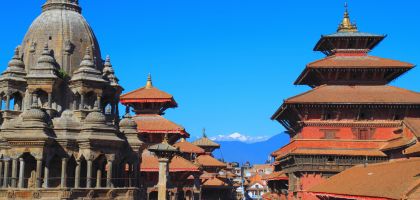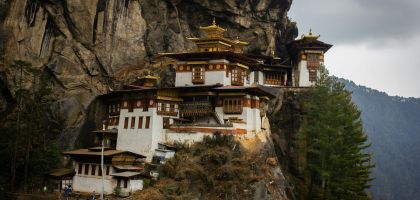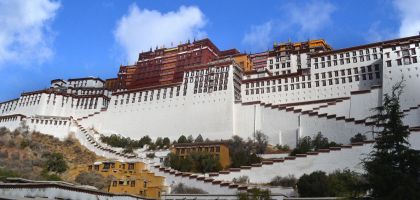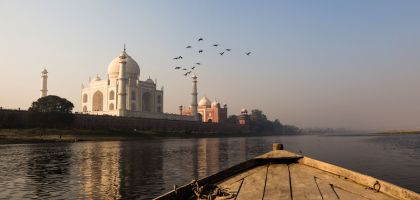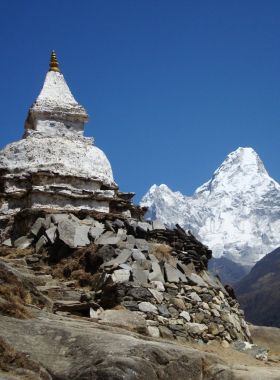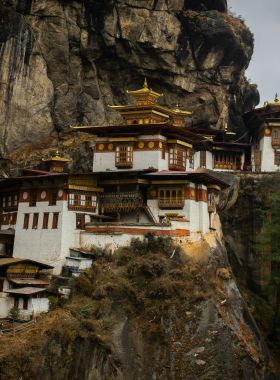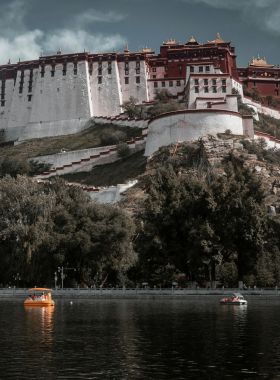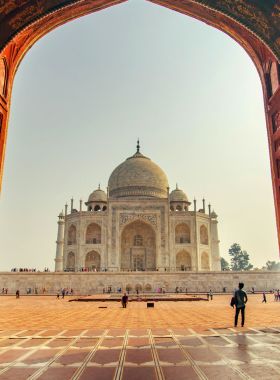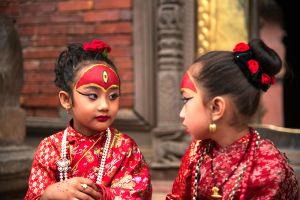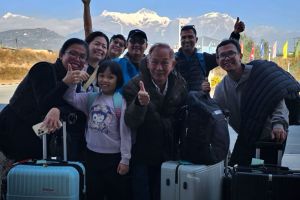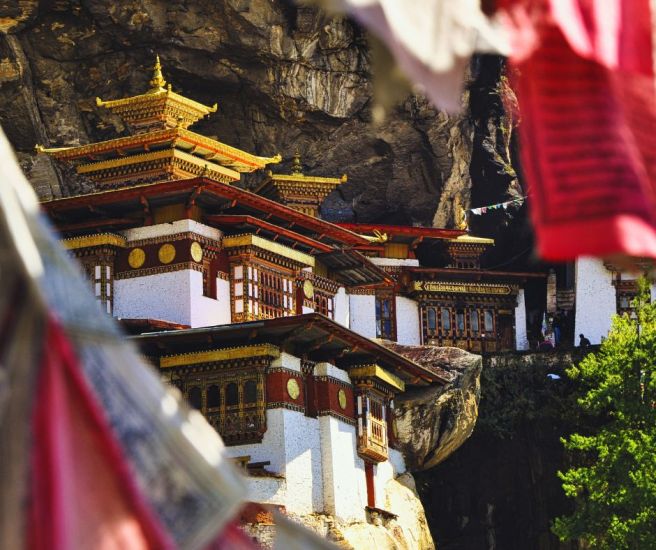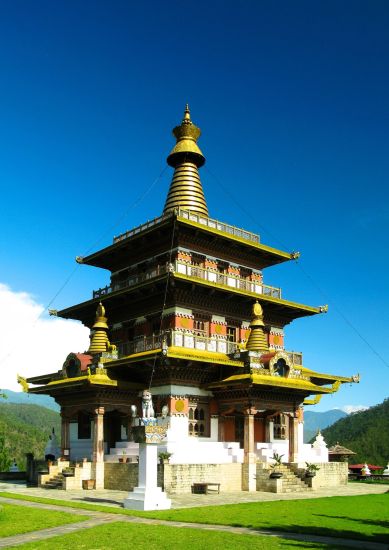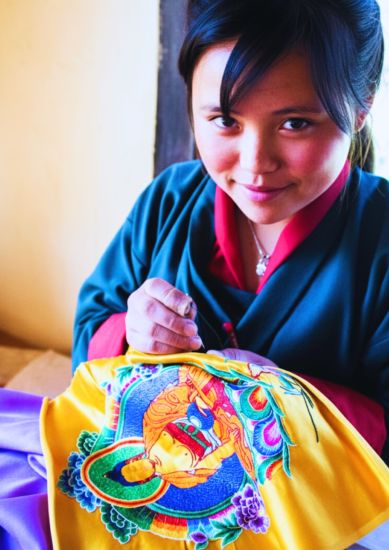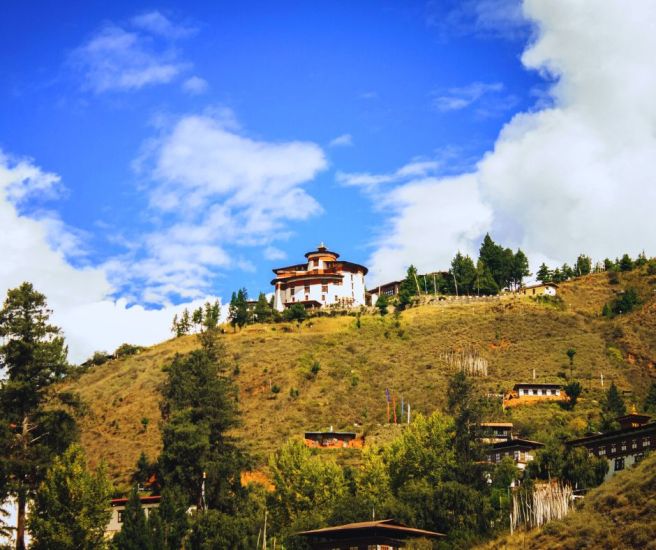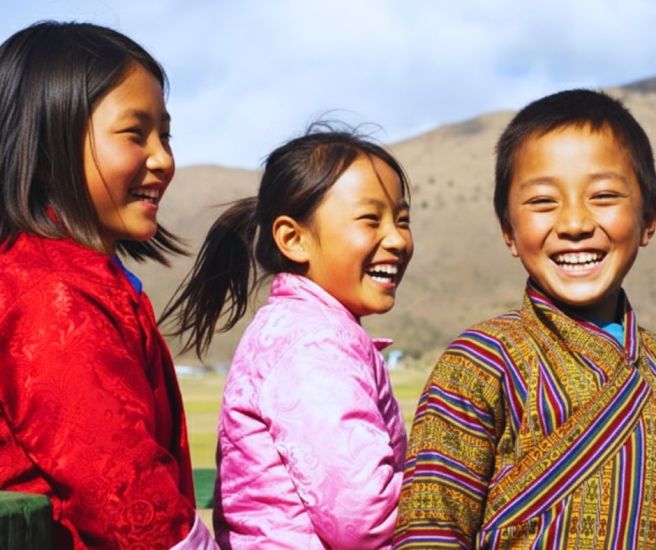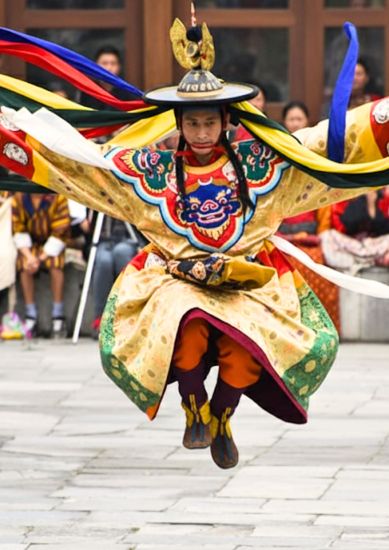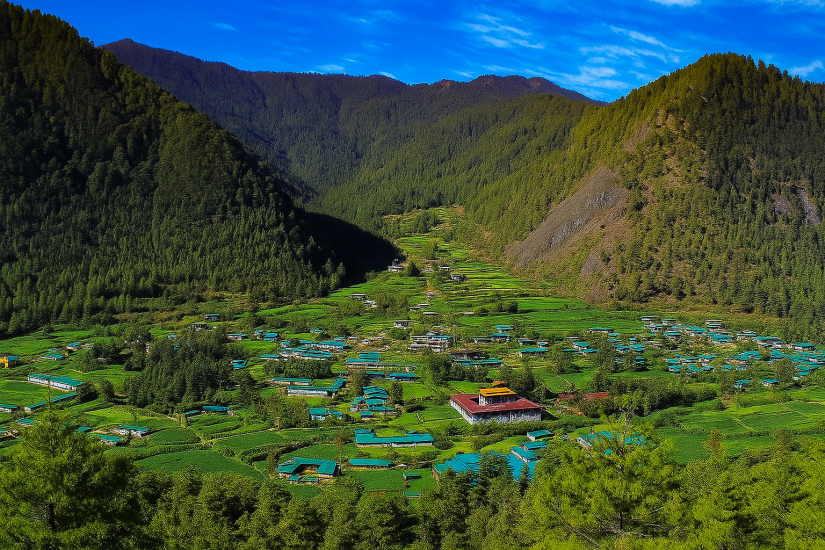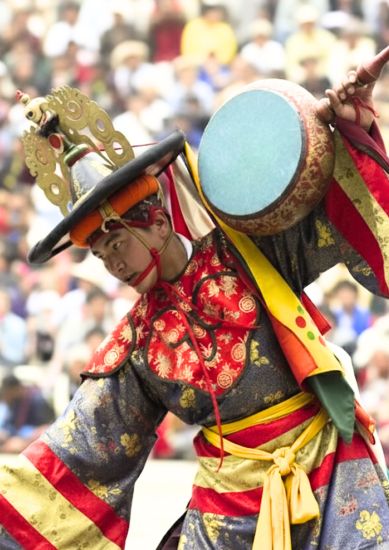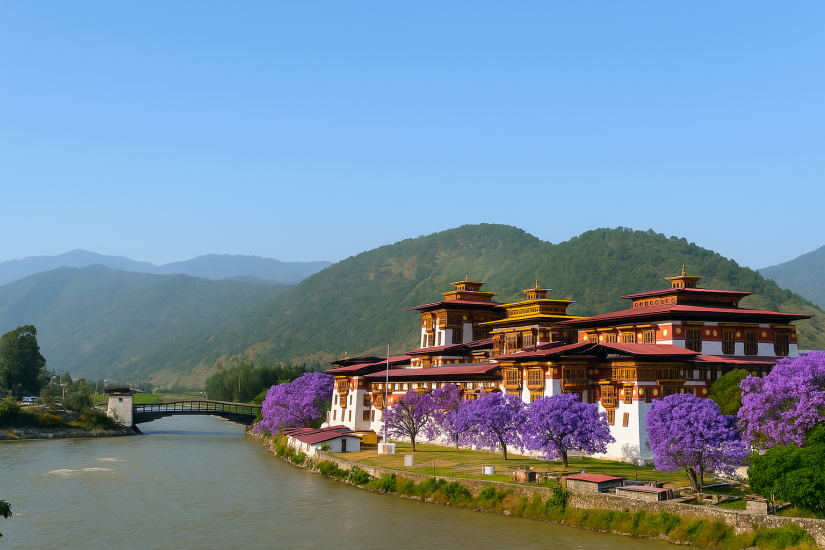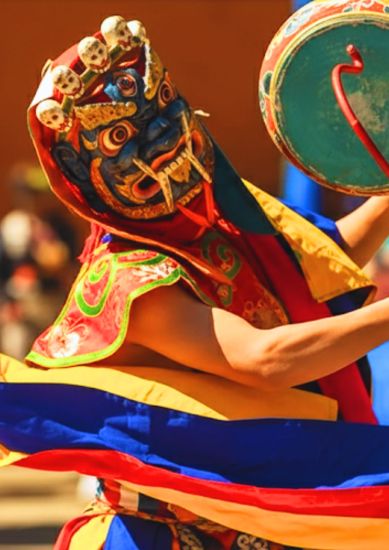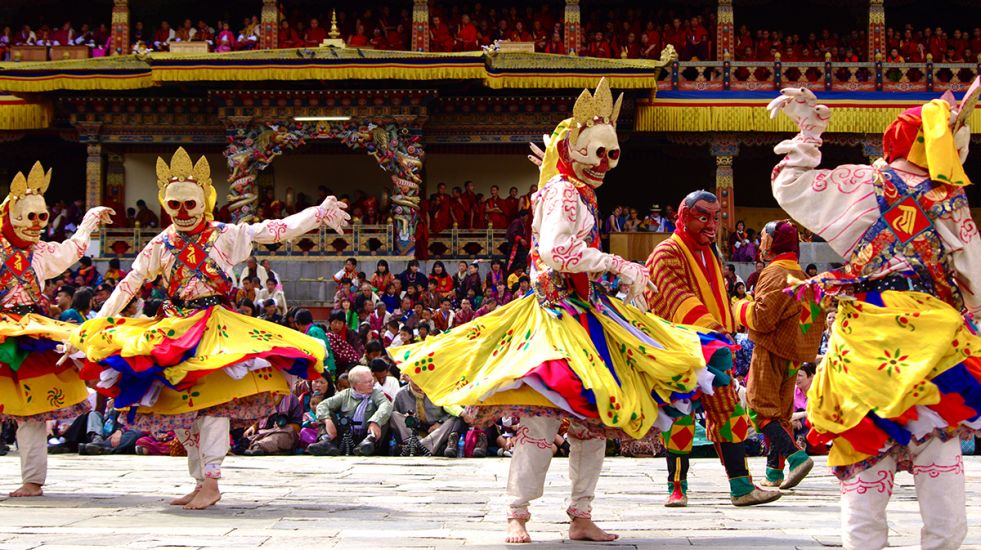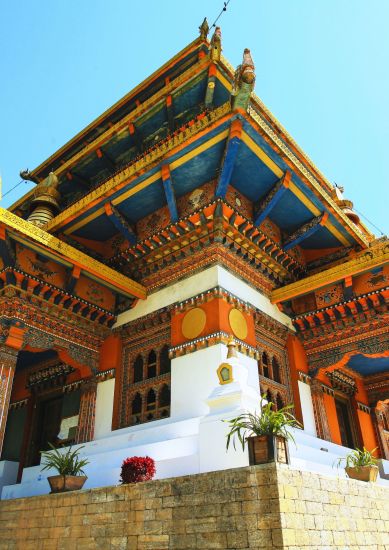Punakha Festival Tour
9 Days / Bhutan
Activity
Difficulty Level
Destinations
Trip Start / End
Accommodation
Travel Style
Best time to travel
Personalized Travel Advice

Dev Raj Nepal
+977 9851096523
Personalized Travel Advice

Dev Raj Nepal
+977 9851096523
Detailed Itinerary
01
DAY
01
Your journey in Bhutan begins with your arrival at Paro International Airport, where you will be warmly greeted. From here, a scenic drive takes you to Thimphu, the capital city, winding along rivers and forested hills. En route, you will stop at Tachogang Lhakhang, also known as the Temple of the Excellent Horse. Built in the 15th century by the Tibetan saint and iron bridge builder Thangtong Gyalpo, the temple is steeped in legend and history. A highlight of the visit is the suspension iron chain bridge draped with prayer flags, which once formed part of his pioneering engineering works and still offers a thrilling walk over the Pa Chhu river. The temple itself houses sacred relics and statues, and its peaceful setting makes it a memorable first introduction to Bhutan’s spiritual heritage.
After the visit, you will continue the drive to Thimphu, where you can settle in and enjoy the evening atmosphere of the capital: the perfect beginning to your Punakha festival tour and wider exploration of Bhutan.
Arrival Paro – Drive to Thimphu
Your journey in Bhutan begins with your arrival at Paro International Airport, where you will be warmly greeted. From here, a scenic drive takes you to Thimphu, the capital city, winding along rivers and forested hills. En route, you will stop at Tachogang Lhakhang, also known as the Temple of the Excellent Horse. Built in the 15th century by the Tibetan saint and iron bridge builder Thangtong Gyalpo, the temple is steeped in legend and history. A highlight of the visit is the suspension iron chain bridge draped with prayer flags, which once formed part of his pioneering engineering works and still offers a thrilling walk over the Pa Chhu river. The temple itself houses sacred relics and statues, and its peaceful setting makes it a memorable first introduction to Bhutan’s spiritual heritage.
After the visit, you will continue the drive to Thimphu, where you can settle in and enjoy the evening atmosphere of the capital: the perfect beginning to your Punakha festival tour and wider exploration of Bhutan.
02
DAY
02
The morning opens with the slow unfolding of Thimphu, a city where ritual and routine blur with the modern pulse of life. Your path first leads to the colossal Buddha Dordenma, seated high above the valley, its golden form gazing down upon the roofs and rivers below. From there, you move toward the Memorial Chorten, its white dome alive with the murmur of mantras and the steady rhythm of prayer wheels turned by devoted hands. At the Institute for Zorig Chusum, young apprentices bend patiently over canvas, wood, and thread, preserving the thirteen traditional arts that are the grammar of Bhutanese culture.
Following lunch, visit the National Textile Museum deepens this sense of continuity, its looms and fabrics telling stories of lineage and identity. A quieter interlude follows at the Postal Museum, where the humble stamp becomes a miniature canvas of national imagination. The day draws to a close at the Crafts Bazaar, a corridor of colors and textures, where artisans display their work against the evening light, inviting you to carry a fragment of Bhutan’s spirit into your own world.
Thimphu Exploration
The morning opens with the slow unfolding of Thimphu, a city where ritual and routine blur with the modern pulse of life. Your path first leads to the colossal Buddha Dordenma, seated high above the valley, its golden form gazing down upon the roofs and rivers below. From there, you move toward the Memorial Chorten, its white dome alive with the murmur of mantras and the steady rhythm of prayer wheels turned by devoted hands. At the Institute for Zorig Chusum, young apprentices bend patiently over canvas, wood, and thread, preserving the thirteen traditional arts that are the grammar of Bhutanese culture.
Following lunch, visit the National Textile Museum deepens this sense of continuity, its looms and fabrics telling stories of lineage and identity. A quieter interlude follows at the Postal Museum, where the humble stamp becomes a miniature canvas of national imagination. The day draws to a close at the Crafts Bazaar, a corridor of colors and textures, where artisans display their work against the evening light, inviting you to carry a fragment of Bhutan’s spirit into your own world.
03
DAY
03
The road out of Thimphu climbs in slow spirals, carrying you higher into the morning mist. Pines thicken, clouds drift low, and soon you arrive at Dochula Pass (3050m), a place where the air sharpens and the horizon opens. Here, 108 chortens stand in concentric silence, their white forms ringed with prayer flags that tremble in the mountain wind. When the skies are clear, the eastern Himalayas rise like a wall of light, distant and austere, a reminder of the vastness that encircles Bhutan.
From the pass, the road begins to descend, uncoiling through forests of rhododendron and oak, the air warming as the valley broadens. Terraces of rice appear, villages gather around riverbanks, and the drive slips gradually into the softer rhythms of Punakha. Before entering the town itself, the journey pauses at Sopsokha village, from where a short twenty-minute walk through fields and farmhouses leads you to Chimi Lhakhang, the temple of fertility built by the Divine Madman, Drukpa Kunley. The walk itself becomes part of the experience, earth underfoot, prayer flags catching the breeze, children calling across the paddies. Within the modest temple, families come to seek blessings, their voices mingling with old stories that still echo in its walls.
By late afternoon, the drive continues into Punakha proper, a valley where two rivers meet and the history of Bhutan feels close at hand. It is here your Punakha festival tour gathers momentum, the sacred and the everyday entwined in the landscape itself.
Thimphu – Punakha
The road out of Thimphu climbs in slow spirals, carrying you higher into the morning mist. Pines thicken, clouds drift low, and soon you arrive at Dochula Pass (3050m), a place where the air sharpens and the horizon opens. Here, 108 chortens stand in concentric silence, their white forms ringed with prayer flags that tremble in the mountain wind. When the skies are clear, the eastern Himalayas rise like a wall of light, distant and austere, a reminder of the vastness that encircles Bhutan.
From the pass, the road begins to descend, uncoiling through forests of rhododendron and oak, the air warming as the valley broadens. Terraces of rice appear, villages gather around riverbanks, and the drive slips gradually into the softer rhythms of Punakha. Before entering the town itself, the journey pauses at Sopsokha village, from where a short twenty-minute walk through fields and farmhouses leads you to Chimi Lhakhang, the temple of fertility built by the Divine Madman, Drukpa Kunley. The walk itself becomes part of the experience, earth underfoot, prayer flags catching the breeze, children calling across the paddies. Within the modest temple, families come to seek blessings, their voices mingling with old stories that still echo in its walls.
By late afternoon, the drive continues into Punakha proper, a valley where two rivers meet and the history of Bhutan feels close at hand. It is here your Punakha festival tour gathers momentum, the sacred and the everyday entwined in the landscape itself.
04
DAY
04
Today, we immerse ourselves in the Punakha Festival within the grand courtyard of Punakha Dzong, an architectural jewel perched at the confluence of the Pho Chhu and Mo Chhu rivers. This historic fortress, once Bhutan’s winter capital, continues to serve as the administrative and spiritual heart of the district, its whitewashed walls and golden rooftops echoing centuries of devotion.
The festival comes alive with elaborate mask dances (Cham), vibrant performances, and sacred rituals, each movement and chant believed to invoke divine blessings and sweep away misfortune. Locals converge from surrounding valleys, clad in their finest kiras and ghos, adorned with shimmering jewelry, forming a living tapestry of Bhutanese culture and reverence. Amid this spectacle, a picnic lunch is served, giving you a chance to pause, absorb the atmosphere, and feel the rhythm of the festival pulse through the courtyard. This day is the highlight of your Punakha festival tour, offering an unforgettable glimpse into Bhutanese tradition and devotion. As evening descends, we return to our hotel, carrying with us the sights, sounds, and spirit of this remarkable celebration.
Punakha Festival Immersion
Today, we immerse ourselves in the Punakha Festival within the grand courtyard of Punakha Dzong, an architectural jewel perched at the confluence of the Pho Chhu and Mo Chhu rivers. This historic fortress, once Bhutan’s winter capital, continues to serve as the administrative and spiritual heart of the district, its whitewashed walls and golden rooftops echoing centuries of devotion.
The festival comes alive with elaborate mask dances (Cham), vibrant performances, and sacred rituals, each movement and chant believed to invoke divine blessings and sweep away misfortune. Locals converge from surrounding valleys, clad in their finest kiras and ghos, adorned with shimmering jewelry, forming a living tapestry of Bhutanese culture and reverence. Amid this spectacle, a picnic lunch is served, giving you a chance to pause, absorb the atmosphere, and feel the rhythm of the festival pulse through the courtyard. This day is the highlight of your Punakha festival tour, offering an unforgettable glimpse into Bhutanese tradition and devotion. As evening descends, we return to our hotel, carrying with us the sights, sounds, and spirit of this remarkable celebration.
05
DAY
05
The morning begins with one last immersion in the Punakha Festival, allowing a final chance to witness the Cham dances, sacred rituals, and vibrant local celebrations within the dzong’s courtyard.
Afterwards, we embark on a scenic drive along the Po Chhu river, winding through rice terraces, small villages, and lush forested hills, leading to the hilltop Khamsum Yulley Chorten. This stunning stupa, built in the late 20th century by the queen mother, stands as a testament to Bhutanese devotion and artistry, with intricate murals depicting Buddhist teachings and a panoramic view of the Punakha Valley below. A gentle walk uphill to the Chorten allows time to soak in the serene surroundings and the spiritual ambiance that envelops the site. The day offers a perfect balance between the vibrant energy of the festival and the tranquil, contemplative beauty of Bhutan’s landscapes, making it an unforgettable highlight of your Punakha festival tour.
Punakha Festival – Khamsum Yulley Chorten
The morning begins with one last immersion in the Punakha Festival, allowing a final chance to witness the Cham dances, sacred rituals, and vibrant local celebrations within the dzong’s courtyard.
Afterwards, we embark on a scenic drive along the Po Chhu river, winding through rice terraces, small villages, and lush forested hills, leading to the hilltop Khamsum Yulley Chorten. This stunning stupa, built in the late 20th century by the queen mother, stands as a testament to Bhutanese devotion and artistry, with intricate murals depicting Buddhist teachings and a panoramic view of the Punakha Valley below. A gentle walk uphill to the Chorten allows time to soak in the serene surroundings and the spiritual ambiance that envelops the site. The day offers a perfect balance between the vibrant energy of the festival and the tranquil, contemplative beauty of Bhutan’s landscapes, making it an unforgettable highlight of your Punakha festival tour.
06
DAY
06
Mist drifts along the valley as we leave Punakha, the rice terraces glinting wet under the morning sun. The road winds through forested hills and river bends until we reach Wangdue Phodrang town, a quiet settlement perched above the valley. Life here moves at a gentle rhythm, with villagers tending to their fields, children chasing one another along narrow streets, and small markets bustling with the hum of local trade. A brief stop allows you to stretch your legs, observe traditional houses with carved wooden windows, and drink in the panoramic views of the valley below.
Continuing toward Paro, the mountains rise sharper, the air crisp with altitude and anticipation. In Paro, we visit Ta Dzong, the former watchtower turned National Museum, housing Bhutan’s priceless artifacts, sacred thangkas, ancient weapons, and historical relics that narrate the kingdom’s story. A short walk brings us to Rinpung Dzong, “Fortress of the Heap of Jewels,” a masterpiece of Bhutanese architecture built in the 15th century. Its massive walls, tiered courtyards, and intricately painted interiors have served as a fortress, monastery, and administrative hub, and today the structure pulses with both historical resonance and living religious devotion. In this space, the journey of your Punakha festival tour comes full circle, a delicate dance of history, culture, and the enduring rhythm of the mountains.
Punakha – Paro
Mist drifts along the valley as we leave Punakha, the rice terraces glinting wet under the morning sun. The road winds through forested hills and river bends until we reach Wangdue Phodrang town, a quiet settlement perched above the valley. Life here moves at a gentle rhythm, with villagers tending to their fields, children chasing one another along narrow streets, and small markets bustling with the hum of local trade. A brief stop allows you to stretch your legs, observe traditional houses with carved wooden windows, and drink in the panoramic views of the valley below.
Continuing toward Paro, the mountains rise sharper, the air crisp with altitude and anticipation. In Paro, we visit Ta Dzong, the former watchtower turned National Museum, housing Bhutan’s priceless artifacts, sacred thangkas, ancient weapons, and historical relics that narrate the kingdom’s story. A short walk brings us to Rinpung Dzong, “Fortress of the Heap of Jewels,” a masterpiece of Bhutanese architecture built in the 15th century. Its massive walls, tiered courtyards, and intricately painted interiors have served as a fortress, monastery, and administrative hub, and today the structure pulses with both historical resonance and living religious devotion. In this space, the journey of your Punakha festival tour comes full circle, a delicate dance of history, culture, and the enduring rhythm of the mountains.
07
DAY
07
Today, we embark on a scenic drive from Paro to Haa Valley, traversing the Chele La Pass at 3,988 meters, the highest motorable point in Bhutan. The ascent is a gradual unfolding of alpine beauty with dense forests of pine and rhododendron, vibrant prayer flags fluttering in the crisp mountain air, and glimpses of snow-capped peaks, including the sacred Mount Jomolhari. The pass offers panoramic views that seem to stretch into eternity, a perfect prelude to the serenity of Haa Valley.
Descending into Haa, the landscape softens into lush valleys and traditional farmhouses. Our first stop is Lhakhang Karpo, the White Temple, established in the 7th century by Tibetan King Songtsen Gampo. According to legend, the king released two doves, one white and one black, to determine the sites for 108 temples. The white dove’s landing marked the location for Lhakhang Karpo, situated at the base of the sacred Meri Puensum mountains. The temple’s pristine white walls and intricate murals exude a sense of peace and reverence.
A short walk through the village leads us to Lhakhang Nagpo, the Black Temple, built in the 15th century. This smaller, more secluded temple contrasts with its counterpart in both size and ambiance, offering a quiet space for reflection. Together, these temples embody the spiritual harmony of Haa Valley, a place where legend and devotion intertwine.
After exploring these sacred sites, we return to Paro, carrying with us the tranquility and timeless beauty of Haa Valley, a perfect complement to the vibrant experiences of your Punakha festival tour.
Excursion to Haa Valley
Today, we embark on a scenic drive from Paro to Haa Valley, traversing the Chele La Pass at 3,988 meters, the highest motorable point in Bhutan. The ascent is a gradual unfolding of alpine beauty with dense forests of pine and rhododendron, vibrant prayer flags fluttering in the crisp mountain air, and glimpses of snow-capped peaks, including the sacred Mount Jomolhari. The pass offers panoramic views that seem to stretch into eternity, a perfect prelude to the serenity of Haa Valley.
Descending into Haa, the landscape softens into lush valleys and traditional farmhouses. Our first stop is Lhakhang Karpo, the White Temple, established in the 7th century by Tibetan King Songtsen Gampo. According to legend, the king released two doves, one white and one black, to determine the sites for 108 temples. The white dove’s landing marked the location for Lhakhang Karpo, situated at the base of the sacred Meri Puensum mountains. The temple’s pristine white walls and intricate murals exude a sense of peace and reverence.
A short walk through the village leads us to Lhakhang Nagpo, the Black Temple, built in the 15th century. This smaller, more secluded temple contrasts with its counterpart in both size and ambiance, offering a quiet space for reflection. Together, these temples embody the spiritual harmony of Haa Valley, a place where legend and devotion intertwine.
After exploring these sacred sites, we return to Paro, carrying with us the tranquility and timeless beauty of Haa Valley, a perfect complement to the vibrant experiences of your Punakha festival tour.
08
DAY
08
The day begins with a sense of anticipation as we set out toward the iconic Tiger’s Nest Monastery (Paro Taktsang), perched dramatically on a cliffside 900 meters above the valley floor. The drive from Paro town brings us to the trailhead, where the forest opens into a path lined with tall pines, fluttering prayer flags, and the soft murmur of streams. The hike itself is moderate, allowing time to pause and absorb the serene surroundings: the scent of pine, the distant call of birds, and the slow unveiling of the monastery as it emerges through the mist. Midway, a quaint cafeteria offers a brief respite and a chance to take in sweeping views of the valley below. Arriving at Paro Taktsang, the monastery’s white walls and golden roofs cling to the rock face, an astonishing blend of natural and human artistry. Inside, sacred murals, prayer halls, and meditation spaces reflect centuries of devotion, while the panoramic vista of Paro Valley rewards every step of the climb.
Optional: After the hike, you have the option to indulge in a traditional hot stone bath, a time-honored Bhutanese practice. Smooth river stones are heated and placed in a wooden tub of water, creating a soothing, mineral-rich soak. The warm water, infused with the heat of the stones, relaxes muscles, improves circulation, and helps relieve tension, making it a perfect way to rejuvenate both body and mind after a day of walking and exploration.
Paro – Hike to Tiger’s Nest
The day begins with a sense of anticipation as we set out toward the iconic Tiger’s Nest Monastery (Paro Taktsang), perched dramatically on a cliffside 900 meters above the valley floor. The drive from Paro town brings us to the trailhead, where the forest opens into a path lined with tall pines, fluttering prayer flags, and the soft murmur of streams. The hike itself is moderate, allowing time to pause and absorb the serene surroundings: the scent of pine, the distant call of birds, and the slow unveiling of the monastery as it emerges through the mist. Midway, a quaint cafeteria offers a brief respite and a chance to take in sweeping views of the valley below. Arriving at Paro Taktsang, the monastery’s white walls and golden roofs cling to the rock face, an astonishing blend of natural and human artistry. Inside, sacred murals, prayer halls, and meditation spaces reflect centuries of devotion, while the panoramic vista of Paro Valley rewards every step of the climb.
Optional: After the hike, you have the option to indulge in a traditional hot stone bath, a time-honored Bhutanese practice. Smooth river stones are heated and placed in a wooden tub of water, creating a soothing, mineral-rich soak. The warm water, infused with the heat of the stones, relaxes muscles, improves circulation, and helps relieve tension, making it a perfect way to rejuvenate both body and mind after a day of walking and exploration.
09
DAY
09
The journey comes to its gentle close as we transfer to Paro International Airport for your onward flight. The mountains, valleys, and dzongs you have visited linger in memory, each sight a quiet echo of Bhutan’s timeless rhythm. There is a sense of reflection in the air, a mix of gratitude and awe for the landscapes, festivals, and sacred spaces that have shaped your experience. Though the journey ends, the impressions of Bhutan — its culture, devotion, and natural beauty, remain, a lasting reminder of your Punakha festival tour.
Paro – Departure
The journey comes to its gentle close as we transfer to Paro International Airport for your onward flight. The mountains, valleys, and dzongs you have visited linger in memory, each sight a quiet echo of Bhutan’s timeless rhythm. There is a sense of reflection in the air, a mix of gratitude and awe for the landscapes, festivals, and sacred spaces that have shaped your experience. Though the journey ends, the impressions of Bhutan — its culture, devotion, and natural beauty, remain, a lasting reminder of your Punakha festival tour.
Tour Cost
At High Asia Tours, we know that understanding tour costs is essential for planning your trip. Due to variables such as accommodation choices, meal plans, transportation options, group size, and seasonal demand, providing an exact price upfront is challenging.
To assist you, we offer a starting price to give a general idea of the cost:
The starting cost for this tour is
Includes / Excludes
Inclusions
-
Accommodation on twin sharing.
-
All transfers and sightseeing as on itinerary.
-
Three meals a day.
-
English speaking local Tour Guide.
-
Sightseeing admission fee.
-
Bhutan visa fee.
Exclusions
-
Airfare to and out of Bhutan.
-
Expenses of personal nature such as drinks, tip, laundry, phone etc.
-
Extra expenses due to nature and unforeseen events.
-
Travel Insurance.
Trip Info
Punakha Dromchoe will be held at Punakha Dzong from February 24 to February 26, 2026. This unique festival is known for its dramatic reenactment of the 17th-century Tibetan invasion, a performance that highlights Bhutan’s military history and spiritual resilience.
Punakha Tshechu will take place at the same venue from February 27 to February 28, 2026 (and possibly extending to March 1, 2026). The Tshechu features sacred mask dances, vibrant cultural displays, and religious rituals, drawing both locals and visitors who gather to receive blessings and to celebrate Bhutan’s living heritage within the grand setting of Punakha Dzong.
Punakha Domchoe (Drubchen)
Preceding the Tshechu is the Punakha Domchoe, also known as the Drubchen, a unique festival that commemorates Bhutan’s victory over Tibetan forces in 1649. Unlike the Tshechu’s spiritual focus, the Domchoe is a theatrical re-enactment of history, dramatizing the martial defense of the Punakha Dzong under the leadership of Zhabdrung Ngawang Namgyal. For three days, the normally serene Dzong and its surrounding grounds are transformed into a stage where villagers dressed as traditional militia — known as pazaps — revive the memory of Bhutan’s struggle for sovereignty.
The Domchoe begins after fifteen days of continuous prayers and mask dances known as the Goenwang Drubchen, dedicated to Bhutan’s guardian deities such as Mahakala. Once these rituals conclude, the pazaps take over the courtyards and riverbanks, performing sword dances, war songs, and mock battles. Eight communities historically tied to Zhabdrung’s cause send their representatives, who don helmets, boots, and weapons provided by the state, re-enacting the defense of Punakha Dzong. The highlight of the Domchoe is the ritual known as “dumping the jewel,” when monks in a colorful procession symbolically cast sacred substances into the Mochu River, recalling the moment when Zhabdrung outwitted Tibetan invaders by pretending to discard the holy relic Rangjung Kharsapani.
As a performance of both devotion and statehood, the Domchoe is more than a local pageant — it is a political ritual. By re-enacting the 17th-century battle, the festival perpetuates the collective memory of Bhutan’s founding and reinforces the centrality of Zhabdrung Ngawang Namgyal in the nation’s historical consciousness. Today, while the Bhutanese monarchy presides over the modern state, the Domchoe remains the only annual festival that theatrically reaffirms Bhutan’s martial past. Together with the Tshechu that follows, it forms a complete cycle: a celebration of both the protection of the Dharma and the defense of the Bhutanese nation.
Punakha Tshechu
The Punakha Tshechu is one of Bhutan’s most celebrated religious festivals, held annually in the grand courtyards of Punakha Dzong. Introduced in the 17th century by Zhabdrung Ngawang Namgyal, it was established to honor Guru Rinpoche (Padmasambhava), the tantric master credited with bringing Buddhism to Bhutan. Coming directly after the martial drama of the Punakha Domchoe, the Tshechu turns the focus toward spiritual blessings, weaving dance, ritual, and devotion into a powerful expression of Bhutanese Buddhist life.
The heart of the Tshechu lies in the sacred cham mask dances, performed by monks and lay dancers in richly colored brocades. These dances retell episodes from Guru Rinpoche’s life, including his subjugation of demonic forces and the safeguarding of the Dharma. The highlight is the unfurling of the giant Thongdrol, a monumental silk scroll depicting Guru Rinpoche, revealed at dawn on the final day. It is believed that a single glimpse of this sacred image can cleanse an individual of lifetimes of negative karma and bestow blessings of liberation.
For the Bhutanese public, the Tshechu is as much a social occasion as it is a religious one. Families gather in their finest traditional attire, elders explain the meaning of the cham to the young, and the Dzong becomes a meeting ground of devotion and festivity. For travelers, it offers an immersive encounter with living Buddhism, a blend of spectacle, faith, and communal joy against the dramatic backdrop of Punakha Dzong.
Punakha Festival Tour
The Punakha Festival Tour is one of the most enriching journeys a traveler can take in Bhutan, combining vibrant celebrations with the exploration of the country’s spiritual heartlands. Centered on the Punakha Domchoe and Tshechu, this tour immerses visitors in the living traditions of Punakha Dzong, where history and devotion meet in dramatic fashion. Travelers witness the Domchoe’s theatrical re-enactment of Bhutan’s 17th-century defense against Tibetan forces, followed by the Tshechu’s sacred mask dances dedicated to Guru Rinpoche. Together, these festivals offer a rare insight into how Bhutan remembers its past and renews its Buddhist faith through ritual, dance, and storytelling.
For tourists, the celebrations are a feast of color and spectacle. Villagers gather in their finest traditional dress, monks perform elaborate cham dances, and the courtyards of Punakha Dzong fill with music, laughter, and prayer. The highlight of the Punakha Festival Tour is the unfurling of the immense Thongdrol, a sacred scroll painting of Guru Rinpoche that is believed to cleanse all sins upon sight. Visitors can watch martial sword dances, join the crowds lining the riverbanks for the symbolic “dumping of the jewel,” and witness the unique blend of theatre, devotion, and community life that defines Bhutanese festivals. It is an atmosphere that is both joyous and reverent, making participation a deeply moving experience.
The Punakha Festival Tour does not stop in Punakha alone. Travelers are also taken to Paro, where Bhutan’s iconic Tiger’s Nest monastery clings to a cliffside; to Thimphu, the bustling capital blending tradition and modernity; and to the remote Haa Valley, known for its pristine landscapes and unspoiled villages. Together, these destinations provide a wider canvas for understanding Bhutan’s culture, history, and way of life. By weaving together sacred festivals and journeys through Bhutan’s valleys and dzongs, the Punakha Festival Tour offers more than sightseeing — it offers an immersion into the living spirit of Bhutan.
The Punakha Festival Tour can be experienced in February or March, when the Punakha Tsechu takes place. This annual festival is held on specific dates according to the Bhutanese lunar calendar, usually around these months. The festival offers a rare opportunity to witness Bhutanese culture in its most vibrant form, with spectacular dances, rituals, and the chance to interact with locals. For those looking to combine the festival with a deeper exploration of Bhutan’s natural beauty, this period also offers pleasant weather for sightseeing and outdoor activities.
Private Vehicles
Throughout the trip, private vehicles will be used for transfers and sightseeing. These include comfortable cars or SUVs, which are good for navigating both urban and rural areas. These vehicles are chosen for their comfort and reliability, ensuring a smooth and enjoyable journey between destinations. They are equipped to handle various road conditions and provide a high level of convenience for travelers.
Minivans or Buses
For group travel of more than 8 people Buses will be used and for a smaller group with more than 3 people, Minivans will be used. These vehicles are suitable for accommodating larger groups and offer ample space for passengers and luggage. Equipped with air conditioning and comfortable seating, these vehicles are designed to enhance travel comfort over longer distances. They also offer better stability and space for scenic drives and excursions.
Hotels in Bhutan are classified by the government into grades A, B, and C, roughly equivalent to 3-4 star hotels internationally. We aim to provide A-grade accommodations in Paro and Thimphu, which are equivalent to international 3 star accommodations. In the rural regions, we will provide you with smaller hotels or guesthouses run by families, ensuring a blend of traditional Bhutanese charm and modern comfort. There is also availability of 4-star luxury boutique hotels in Paro, Thimphu and Punakha which can be included upon advanced request.
Bhutanese cuisine, available in restaurants and hotels alike, revolves around rice as a staple, complemented by an array of flavorful side dishes that include lentils, meat, and vegetables. The culinary experience in Bhutan caters to all preferences, whether you follow a vegetarian diet or enjoy non-vegetarian fare. You can expect a diverse selection of dishes, each crafted to highlight the unique spices and ingredients of Bhutan, ensuring a rich and satisfying meal for every palate.
Cultural Immersion: As part of this Bhutan Festival Tour, you will dive deep into Bhutan’s rich heritage through the vibrant Punakha Festival. Experience traditional Bhutanese dances, sacred rituals, and mesmerizing mask dances performed by monks and laymen in the striking Punakha Dzong. The colorful costumes and dramatic performances will leave you awestruck as you witness the blending of spirituality and cultural celebration.
Festive Atmosphere: Punakha Festival is a celebration that gathers locals from various regions, all coming together in their finest attire and jewelry to seek blessings. The festival’s atmosphere is filled with joy, unity, and devotion, offering you a unique chance to interact with the Bhutanese people, observe their traditions, and share in the excitement of this sacred event.
Breathtaking Scenery: Bhutan’s natural beauty is a highlight of this tour. From the lush valleys surrounding Punakha Dzong to the snow-capped peaks of the Himalayas, the landscape will leave you spellbound. You’ll explore areas like Gangtey, known for its stunning valley views, and Haa Valley, which remains one of Bhutan’s most pristine and scenic areas. Each destination offers a chance to capture the beauty of Bhutan’s untouched nature.
Historic and Spiritual Sites: Throughout your Bhutan Festival Tour, you’ll visit some of Bhutan’s most iconic historical and religious sites. The majestic Punakha Dzong, the ancient temples of Paro, and the monasteries in Gangtey will provide insight into Bhutan’s spiritual and cultural evolution. These sites offer more than just scenic views – they are living symbols of Bhutan’s rich religious traditions and architectural wonders.
Adventure and Hiking: The tour includes scenic hikes through dense forests, mountain trails, and remote villages, where you can enjoy the tranquility and beauty of Bhutan’s rural landscapes. The hike to Phajoding, in particular, offers panoramic views of the Thimphu Valley and surrounding peaks, giving you a sense of peace and connection with nature.
Local Interactions: Throughout the tour, you’ll have the chance to engage with the friendly Bhutanese locals, from the monks at the monasteries to the villagers in the rural areas. These interactions will deepen your understanding of Bhutanese life, culture, and spirituality, making this Bhutan Festival Tour a truly immersive and enriching experience.
FAQs
Personalized Travel Advice

Dev Raj Nepal
+977 9851096523
